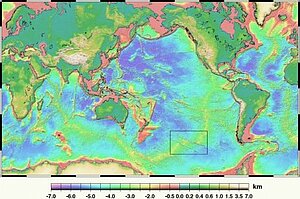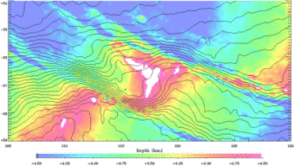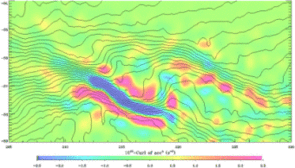Eddy-steered current
Image of the month - April 2004
Sea surface temperature contour levels superimposed on bathymetry, and the "twisting force" exerted by eddies (from altimetry): in blue, eddies permit the current to flow to the south. (Credits Proudman Oceanographic Laboratory (POL) )
Why study eddies? One can think that such rather small features have little impact on the global ocean. But, in fact, eddies impact on current speed, and they can steer them.
We saw (Image of the Month, July 2003) that currents can be steered by gaps in the ocean ridges, like at the Eltanin fracture zone (at about 230°E, 58°S in the Southern Ocean). The strong "jets" (i.e. narrow, fast currents) thus created have something strange: if they were only steered by the Earth rotation, they shouldn't go south. But they do. That normally require twisting force to allow the water to move over the earth's curvature. The answer is that eddies exert a twisting force by carrying vorticity from the jet's centre.

Global bathymetry from altimetry data
(Credits UCSD/Scripps Institution of Oceanography)
See also:
- Image of the Month: July 2003, Currents steered by gaps in the ridges
Websites on this subject:
- Antarctic Circumpolar Current (Ocean Surface Currents, Hycom Consortium)
References
- Hughes, C.W., and E. R. Ash, 2001: Eddy Forcing of the mean flow in the Southern Ocean. J. Geophys. Res., 106(C2), 2713-2722.






